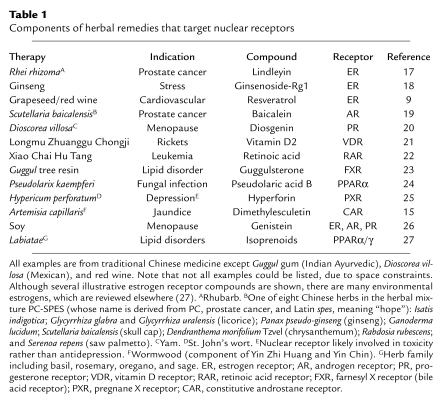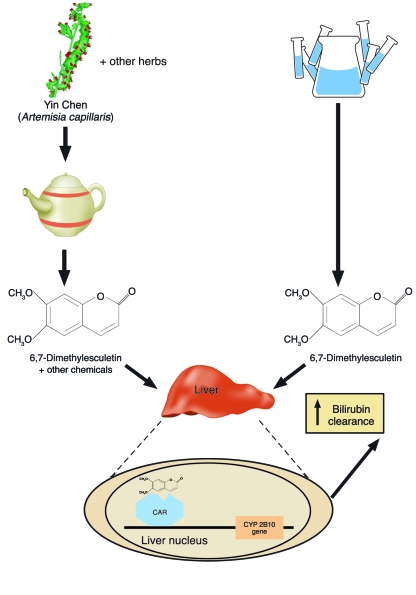Abstract
Jaundice, which is caused by accumulation of bilirubin, is extremely common in newborn infants. Phototherapy is an effective treatment, but a drug therapy would also be desirable. A Chinese herbal remedy for jaundice called Yin Zhi Huang is now shown to activate a liver receptor that enhances the clearance of bilirubin (see the related article beginning on page 137). This discovery could lead to improved pharmaceutical treatments for neonatal jaundice.
Advances in Western medicine have dramatically increased health and life expectancy (1). Nevertheless, over $4 billion is spent per year on herbal remedies that are complementary or alternative to Western-style care (2). Prescription medicines are usually purified molecules whose biological target is established and whose efficacy is endorsed by regulatory agencies. By contrast, herbal medicines often contain many ingredients whose effects on biochemical pathways are unknown and whose efficacy is unproven in controlled studies. A report in the current issue of the JCI helps to bridge this gap. David Moore and colleagues (3) show the improvement of jaundice by a Chinese herbal tea called Yin Zhi Huang (YZH), “boiled down” to one component that regulates the activity of a nuclear receptor previously implicated in bilirubin clearance (4, 5). This discovery provides a mechanistic rationale for pursuing an ingredient in YZH as a lead to improve upon the standard Western treatment for fetal jaundice.
While there’s tea, there’s hope. —Sir Arthur Pinero
Herbal remedies are often produced in the form of tea, that is, a decoction of dried plant leaves in boiling water. In today’s Western world, teas serve as beverages for enjoyment as well as for herbal therapies. The former use has widespread acceptance, whereas the therapeutic use of tea is not espoused by mainstream Western medicine, largely because Western pharmacology has focused on purified chemical compounds, with defined mechanisms of action, whose effectiveness has been proven in controlled studies. By contrast, most teas used for medicinal purposes are admixtures of phytochemicals whose efficacy and biological target(s) are unproven by Western standards. This can threaten relationships between physicians guided by the Western medical literature and millions of their patients who opt to use teas preventively or therapeutically for cancer, inflammatory disease, and metabolic disease (6). At the same time, Eastern remedies may contain critical clues for disorders that have been refractory to Western medicine.
Nuclear receptors as targets of herbal remedies
Holistic medicine holds that herbal remedies work better when the whole complex of plant phytochemicals is kept together than when these chemicals are purified and administered singly or in combination. This hypothesis is difficult to put to stringent experimental test and remains a divisive point between Eastern and Western approaches. On the other hand, investigation of herbal remedies has revealed individual components that target nearly all classes of signaling molecules. For mechanism-based scientists and physicians, including myself (and presumably much of the JCI readership), it is both satisfying and reassuring when a single component of an herbal remedy turns out to function via a defined mechanism. Members of the nuclear receptor superfamily of ligand-regulated transcription factors are frequent biological targets of active compounds contained in herbal remedies. This is perhaps not surprising, since nuclear receptors evolved to be regulated by lipophilic molecules derived from diet and the environment (7, 8).
There are 48 nuclear receptors, some of which are “orphans,” meaning that no endogenous ligand has yet been found (9). At least ten of these receptors have been shown to be directly activated by compounds purified from herbal remedies (Table 1). Some compounds have a complex pharmacology; for example, grapeseed-derived resveratrol is an estrogen receptor ligand (10) but has also been suggested to activate a histone deacetylase enzyme implicated in the biology of aging (11). Other phytochemicals target multiple nuclear receptors (see Table 1 for examples). The pharmaceutical industry is now exploiting similar, less specific compounds, such as antidiabetic drugs that activate both PPARα and PPARγ (12). Indeed, although purified hormones have mostly replaced glandular extracts in Western medicine (13), a natural extract of pregnant mare’s urine containing at least ten estrogenic compounds is a widely prescribed treatment for menopausal symptoms (14).
Table 1.
Components of herbal remedies that target nuclear receptors
When things are investigated, then true knowledge is achieved. —Confucius
Neonatal jaundice is extremely common and may lead to neurotoxicity (15). The treatment of choice for this condition in Western medicine is ultraviolet light therapy; pharmaceutical treatments have not been popular. Two groups have recently noted that the nuclear receptor constitutive androstane receptor (CAR) enhances bilirubin clearance (3, 4). In the present issue of the JCI, noting that Chinese medicine uses YZH and a tea called Yin Chin for the treatment of jaundice, Huang et al. test the hypothesis that the Chinese remedies exert their effects via this mechanism (3). YZH and Yin Chin were obtained not from a chemical supplier but from a Chinese-herb store, were prepared as teas, and then were administered to mice (Figure 1). The herbal teas accelerated the clearance of bilirubin in normal mice, but not in mice that had been genetically engineered to lack CAR, demonstrating a critical role for this nuclear receptor. But that is only half of the story — the teas contain many ingredients, including one component (Scutellaria) that has been shown to contain an androgen receptor ligand (Table 1). However, the systematic study by Huang et al. reveals that a single compound found in both YZH and Yin Chin (6,7-dimethylesculetin) is sufficient to activate CAR and induce bilirubin clearance. This is a wonderful example of knowledge gained by applying the Western scientific method to an Eastern herbal remedy. It will be very exciting if a pure compound emerges from the tea leaves as a pharmacological therapy for neonatal jaundice that is complementary or alternative to the current Western practice of phototherapy (16).
Figure 1.
Eastern and Western paths to medicine. 6,7-Dimethylesculetin, in a wormwood tea or as a purified chemical, binds to and activates the hepatic nuclear receptor CAR and its target genes including CYP 2B10, leading to increased bilirubin clearance. Brewing of wormwood yields a tea that contains other chemicals, with potential for additional benefit or toxicity, or both.
Footnotes
See the related article beginning on page 137.
Conflict of interest: The author has declared that no conflict of interest exists.
Nonstandard abbreviations used: Yin Zhi Huang (YZH); constitutive androstane receptor (CAR).
References
- 1.Kinsella, K., and Gist, Y.J. 1998. Gender and Aging: Mortality and Health. U.S. Department of Commerce, U.S. Bureau of the Census. Washington, D.C. 1B/98-2.
- 2.Carey, J. 2003. Herbal remedies: a $4 billion enigma. BusinessWeek online, 28 April. http://www.businessweek.com/magazine/content/03_17/b3830095_mz025.htm.
- 3.Huang W, Zhang J, Moore DD. A traditional herbal medicine enhances bilirubin clearance by activating the nuclear receptor CAR. J. Clin. Invest. 2004;113:137–143. doi:10.1172/JCI200418385. doi: 10.1172/JCI200418385. [DOI] [PMC free article] [PubMed] [Google Scholar]
- 4.Huang W, et al. Induction of bilirubin clearance by the constitutive androstane receptor (CAR) Proc. Natl. Acad. Sci. U. S. A. 2003;100:4156–4161. doi: 10.1073/pnas.0630614100. [DOI] [PMC free article] [PubMed] [Google Scholar]
- 5.Xie W, et al. Control of steroid, heme, and carcinogen metabolism by nuclear pregnane X receptor and constitutive androstane receptor. Proc. Natl. Acad. Sci. U. S. A. 2003;100:4150–4155. doi: 10.1073/pnas.0438010100. [DOI] [PMC free article] [PubMed] [Google Scholar]
- 6.Eisenberg DM. Advising patients who seek alternative medical therapies. Ann. Intern. Med. 1997;127:61–69. doi: 10.7326/0003-4819-127-1-199707010-00010. [DOI] [PubMed] [Google Scholar]
- 7.Chawla A, Repa JJ, Evans RM, Mangelsdorf DJ. Nuclear receptors and lipid physiology: opening the X-files. Science. 2001;294:1866–1870. doi: 10.1126/science.294.5548.1866. [DOI] [PubMed] [Google Scholar]
- 8.Lazar, M.A. 2003. Mechanism of action of hormones that act on nuclear receptors. In Williams textbook of endocrinology. P.R. Larsen, H.M. Kronenberg, S. Melmed, and K.S. Polonsky, editors. W.B. Saunders Co. Philadelphia, Pennsylvania, USA. 35–44.
- 9.Willson TM, Moore JT. Genomics versus orphan nuclear receptors: a half-time report. Mol. Endocrinol. 2002;16:1135–1144. doi: 10.1210/mend.16.6.0849. [DOI] [PubMed] [Google Scholar]
- 10.Klinge CM, et al. Estrogenic activity in white and red wine extracts. J. Agric. Food Chem. 2003;51:1850–1857. doi: 10.1021/jf0259821. [DOI] [PubMed] [Google Scholar]
- 11.Howitz KT, et al. Small molecule activators of sirtuins extend Saccharomyces cerevisiaelifespan. Nature. 2003;425:191–196. doi: 10.1038/nature01960. [DOI] [PubMed] [Google Scholar]
- 12.Etgen GJ, et al. A tailored therapy for the metabolic syndrome: the dual peroxisome proliferator-activated receptor-alpha/gamma agonist LY465608 ameliorates insulin resistance and diabetic hyperglycemia while improving cardiovascular risk factors in preclinical models. Diabetes. 2002;51:1083–1087. doi: 10.2337/diabetes.51.4.1083. [DOI] [PubMed] [Google Scholar]
- 13.Schwartz TB. Henry Harrower and the turbulent beginnings of endocrinology. Ann. Intern. Med. 1999;131:702–706. doi: 10.7326/0003-4819-131-9-199911020-00012. [DOI] [PubMed] [Google Scholar]
- 14.Bhavnani BR. Estrogens and menopause: pharmacology of conjugated equine estrogens and their potential role in the prevention of neurodegenerative diseases such as Alzheimer’s. J. Steroid Biochem. Mol. Biol. 2003;85:473–482. doi: 10.1016/s0960-0760(03)00220-6. [DOI] [PubMed] [Google Scholar]
- 15.Stevenson DK, Wong RJ, Hintz SR, Vreman HJ. The jaundiced newborn. Understanding and managing transitional hyperbilirubinemia. Minerva Pediatr. 2002;54:373–382. [PubMed] [Google Scholar]
- 16.Dennery PA, Seidman DS, Stevenson DK. Neonatal hyperbilirubinemia. N. Engl. J. Med. 2001;344:581–590. doi: 10.1056/NEJM200102223440807. [DOI] [PubMed] [Google Scholar]
- 17.Usui T, et al. The phytochemical lindleyin, isolated from Rhei rhizoma, mediates hormonal effects through estrogen receptors. J. Endocrinol. 2002;175:289–296. doi: 10.1677/joe.0.1750289. [DOI] [PubMed] [Google Scholar]
- 18.Chan RY, Chen WF, Dong A, Guo D, Wong MS. Estrogen-like activity of ginsenoside Rg1 derived from Panax notoginseng. J. Clin. Endocrinol. Metab. 2002;87:3691–3695. doi: 10.1210/jcem.87.8.8717. [DOI] [PubMed] [Google Scholar]
- 19.Hsieh TC, Lu X, Chea J, Wu JM. Prevention and management of prostate cancer using PC-SPES: a scientific perspective. J. Nutr. 2002;132(Suppl.):3513S–3517S. doi: 10.1093/jn/132.11.3513S. [DOI] [PubMed] [Google Scholar]
- 20.Zava DT, Dollbaum CM, Blen M. Estrogen and progestin bioactivity of foods, herbs, and spices. Proc. Soc. Exp. Biol. Med. 1998;217:369–378. doi: 10.3181/00379727-217-44247. [DOI] [PubMed] [Google Scholar]
- 21.Zhang LN, et al. Determination of vitamin D2 included with beta-cyclodextrin complex in “longmu zhuanggu chongji” by HPLC. Se Pu. 2000;18:52–54. [PubMed] [Google Scholar]
- 22.Huang ME, et al. Use of all-trans retinoic acid in the treatment of acute promyelocytic leukemia. Blood. 1988;72:567–572. [PubMed] [Google Scholar]
- 23.Urizar NL, et al. A natural product that lowers cholesterol as an antagonist ligand for FXR. Science. 2002;296:1703–1706. doi: 10.1126/science.1072891. [DOI] [PubMed] [Google Scholar]
- 24.Jardat MS, Noonan DJ, Wu B, Avery MA, Feller DR. Pseudolaric acid analogs as a new class of peroxisome proliferator-activated receptor agonists. Planta Med. 2002;68:667–671. doi: 10.1055/s-2002-33785. [DOI] [PubMed] [Google Scholar]
- 25.Moore LB, et al. St. John’s wort induces hepatic drug metabolism through activation of the pregnane X receptor. Proc. Natl. Acad. Sci. U. S. A. 2000;97:7500–7502. doi: 10.1073/pnas.130155097. [DOI] [PMC free article] [PubMed] [Google Scholar]
- 26.Beck V, Unterrieder E, Krenn L, Kubelka W, Jungbauer A. Comparison of hormonal activity (estrogen, androgen and progestin) of standardized plant extracts for large scale use in hormone replacement therapy. J. Steroid Biochem. Mol. Biol. 2003;84:259–268. doi: 10.1016/s0960-0760(03)00034-7. [DOI] [PubMed] [Google Scholar]
- 27.Takahashi N, et al. Dual action of isoprenols from herbal medicines on both PPARgamma and PPARalpha in 3T3-L1 adipocytes and HepG2 hepatocytes. FEBS Lett. 2002;514:315–322. doi: 10.1016/s0014-5793(02)02390-6. [DOI] [PubMed] [Google Scholar]




